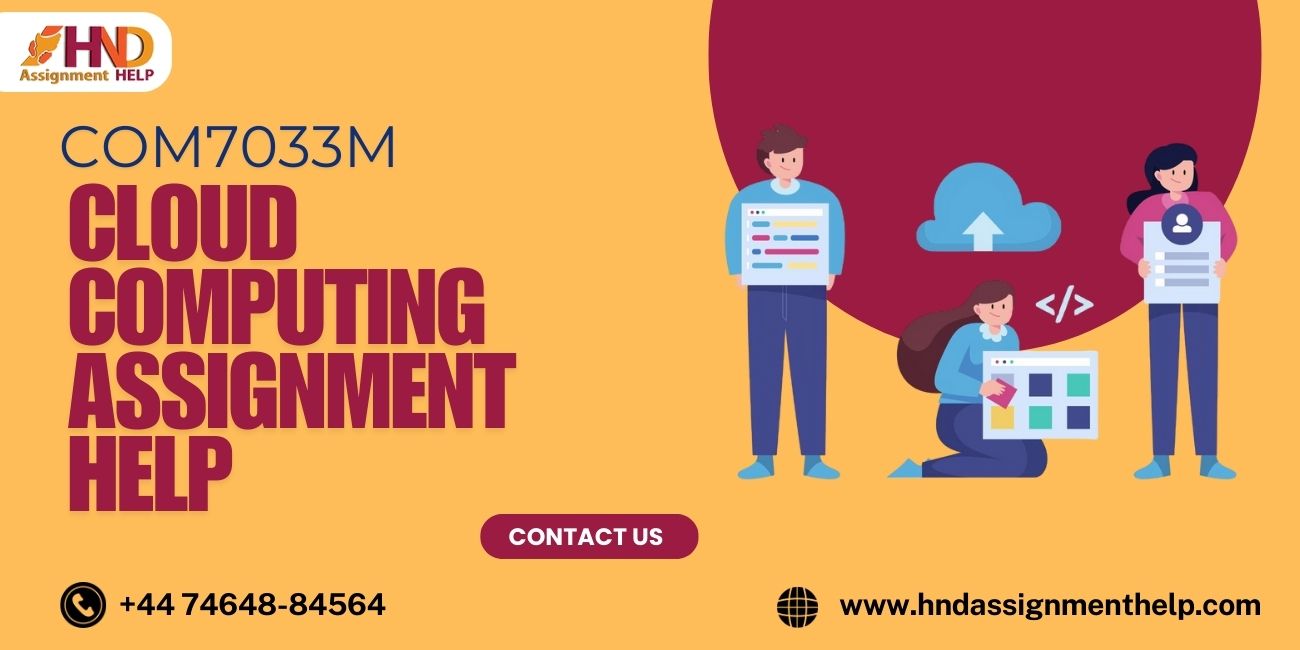Assignment help

Join our 150К of happy users
Get original papers written according to your instructions and save time for what matters most.


COM7033M Cloud Computing Assignment Help
Cloud Computing Assignment Brief
Contents
Module Details......................................................................................................................... 1
Assignment Description......................................................................................................... 2
Learning Outcomes................................................................................................................. 3
Advice and Guidance.............................................................................................................. 4
Assessment Marking Information.......................................................................................... 6
Detailed Marking Criteria...................................................................................................... 11
| ModuleDetails | |||
| Modulecode: | COM7033M- 2024-25 | Levelof Study: | 7 |
| ModuleLeader(s): | Mr Issa Barkad (ModuleDirector) Dr Soonleh Ling (Deputy Module Director) | Credits: | 15 |
| Assessmentformat: | Artefacts | Method of submission: | Turnitinwithin Moodle |
| Deadline or AssessmentPeriod: | 14thJan2025, 12Noon | Feedbackdateand place: | 5thFeb 2025, Writtenfeedback within Turnitin/Moodle |
Assessmentlimits: length,load,wordcount, etc. | N/A | Componentnumber: | 1of1 |
Is this exempt from anonymousmarking underthepolicy? | No | Component weighting: | 100% |
| AssignmentDescription |
This coursework is designed to demonstrate the broad understanding and knowledge of the Cloud Computing (CC), assessing and evaluating the student’s strength and level of analysis. The assessment consists of a series of questions, with the objectives to achieve the learning outcomes from the module:
Youarerequiredtoproduceanindependentcreativeartefacttocriticallyevaluate the questions, paying particular attention to the level of depth required to answer those questions by applying the learning in both online lectures and seminar sessions.
Itisimportantthatthecontentisunderpinnedwiththeinclusionofrelevantacademic theory,concepts,andmodelswhereappropriate,aswellascontemporaryindustrial insights. These should be accurately cited and referenced according to York StJohn Harvard Referencing throughout. Please find the detailed assessment criteria for each part in the Assessment Marking Information section.
Part1– [20marks]
Part2– [20marks]
|
| AssignmentDescription |
Part3– [20marks]
Part4–[30 marks]
|
| LearningOutcomes (LOs) |
ProgrammeLearningOutcomes(PLOs)7.1-7.7:
|
If you want to enhance your understanding and performance in HND coursework, visit our HND Assignment Help section for expert insights and support.
| Adviceand Guidance |
GuidelinesforStudents: Studentsmustsubmittheirownwork.Theymustacknowledgethesourcesusedin this assignment, failure to acknowledge would be plagiarism which is an academic offence and a penalty can be imposed. Students need to write by reading other papersontheirownwithcitationsandleavereferencesattheendoftheassignment. Students work would be submitted to the national plagiarism facility. This identifies the sources from the internet and other extensive databases. Once the student’s work has been submitted to detection services, work is stored in databases electronically and compared their work from other sources. It is necessary to keep a backup of their work. Students’ materials would be stored in the database electronically for indefinite periods.
It isessentialthatyouacknowledgethe source ofanyresearch,information,ideas, opinions, theories, or other material which is not your own. Effective referencing, quoting, paraphrasing, and summarising show evidence of the reading you have done and ensure that you avoid accusations of plagiarism.
The University's fundamental stance on the use of Turnitin is geared toward supporting students' academic development. You can use this link to check your work for areas where you might be at risk of plagiarising.
Please submit your assignment on time. All assignments may be electronically submittedusingTurnitin(viaMoodle)bymidnightontheduedate.Pleasedonot submit your assignment last minute. Please also allow time for any problems or issues with systems.
Theworkyoupresentshouldbeyourownwork,andnotjustcopiedfrom others.You can quote from others, but you must say who the author is and use quotation marks or paraphrase.If you do not do so, we will investigate your work foracademicmisconduct.ThisisparticularlylikelyifyourTurnitinsimilarityscoreis above 25% and/or individual matches are above 6%.
Ifyourequiresupportwithyourstudyskills,pleasevisit https://www.yorksj.ac.uk/students/study-skills/
Please refer to the York St John University Code of Practice for Assessment and Academic Related Matters 2023-24.
We ask that you pay particular attention to the academic misconduct policy. Penalties will be applied wherea student isfound guilty of academicand/or ethical misconduct, including termination of programme (Policy Link). |
| Adviceand Guidance |
You are also required to keep to the word limit set for an assessment and to note that you may be subject to penalty if you exceed that limit.You are required to provideanaccuratewordcountonthecoversheetforeachpieceofworkyousubmit (Policy Link). For late or non-submission of work by the published deadline or an approved extended deadline, a mark of 0NS will be recorded. Where a re-assessment opportunity exists, a student will normally be permitted only one attempt to be re- assessed for a capped mark (Policy Link). An extension to the published deadline may be granted to an individual student if they meet the eligibility criteria of the (Policy Link). |
| AdditionalInformation |
ThecreativeartefactshouldbecreatedusingMicrosoftWord.Youhaveaccessto Microsoft software for free through your university account.
Yourcreativeartefactshouldincludethefollowingareas:
The artefact should contain all the relevant information but also be professional including the use of graphs, tables, and figures as appropriate. You will be assessedonthecreativityofyourartefact,applicationoftheoryandknowledge,as well as your use of research and referencing throughout.
Yourworkneedsto:
|
| AssessmentMarkingInformation |
Yourworkwillbemarkedaccordingtotheassessmentinstructionsprovidedwithinthis document and the selected Learning Outcomes’ (LOs) (see above). This assessmentismarked usingtheassessmentmarkingcriteriaora similar rubricthat alignswiththeUniversity’sGenericAssessmentDescriptors(GAD).1Thisistoensureall assessment decisions are comparable regardless of the discipline or mode of assessment. Please note that you must meet the required baseline standards (50 – 59%) which will include the LOs and minimum expectations of the assessment. Further still, you must ensure youmeettherequirementsof eachgradeboundarytoprogresstothenext, i.e., you should demonstrate your learning through the standards of the Pass, Merit and DistinctiontoreacharequiredDistinction(70–84%).Thesestandardsaredesignedto scaffold and build your learning to achieve your fullest potential in each criterion being assessed. |
| QuestionPart | Deliverables | Marks |
Part1 |
|
20 |
1Arubricisatypeofscoringguidethatmarkersusetosetoutspecificcomponentsandexpectationsforanassignmentfortheirstudents.Itisthenusedtoguidethemarkingtheyundertake.
| ||
Part 2 |
|
20 |
| ||
Part 3 |
|
20 |
withcomprehensivedescriptionoftheAPI'sfunctionalityand how it is utilized within the application. (3 Marks)
| ||
Part 4 |
|
30 |
| ||
Communication |
|
10 |
| Totalmarks | 100 |
| DetailedMarkingCriteria |
TotalAvailableMarks(%):100 PassGradeBands(100–50)(LearningOutcomesmustbe met) FailGradeBands(49–0)(LearningOutcomesarenotmet) NotethatthedetailedmarkingcriteriabelowarederivedfromtheYSJUGADtable. |
| QuestionPart | Pass(50–59) | Merit(60–69) | Distinction (70–84) | Distinction(85– 100) | BorderlineFail (45–49) | Fail(30–44) | Fail(0–29) |
Part 1: Cloud ServiceModels, Business ImpactAnalysis & Risk Management | The learner has attempted to apply advanced thinking skills methodically to materialfromthe taught content (core and additional) andto present an evidence-led understandingof the topic. | The learner has systematically applied advanced critical thinking skillstothe(taught and independently researched) material. It has identifiedproblems with, or asked questions about, the sourcematerial and proposed appropriate approaches to resolve these. | Thelearnerhas successfully offered and evidenced new insights into problems or areas of development which are central to research in this discipline. | The learner has created new insights or proposed new hypotheses (where appropriate) in response to problemsorareas of development which are at the forefront of research in this discipline. It shows a professional awareness and application of the thinking skills used to process thisknowledge. | The learner may haveappliedsome thinking skills to part of the existing knowledge from the taught content, but not enough of these are advanced thinking skills. More of the corecontentneeds tobeaddressedor applied in this work. | The learner has applied a few thinking skills to the materials fromthecorecontent, but none of these are advanced thinking skills.Mostofthecore content has not been addressed or applied. The work is limited by some misunderstandings, misapplications, or gaps in key areas of knowledge from the taught content. | The learner has not applied the required thinking skills to the course content. Little ornocorecontenthas been addressed or applied. The work is limited by significant misunderstandings, misapplications, or gaps in key areas of knowledge from the taught content. |
Part2:Backup Policies for BC/DR, Cloud Offering Comparison | The learner demonstrates a satisfactory understandingof backup policies and cloud service comparisons, | The learner has provided a good analysisofbackup strategies and cloud provider features. The comparison table iscomprehensive, | The learner demonstrates excellent analysis, providing detailed comparisons and | The learner’s work is exemplary, offering new insights or approachesto cloud service comparisons.The | The learner has identified some backuppoliciesbut has not provided enough depth in the comparison. Diagramsortables are limited, and | Thelearnerhasshown limited understanding of cloud service backup policies, with insufficientcomparison and minimal use of diagrams or tables. Keyfeatureslike | The learner has failed to identify backup policies or make a meaningful comparison of cloud services.Thereislittle ornouseofdiagrams, |
| with basic identification of cloud service providers and descriptions of features. The useofdiagrams or tables is basic. | with solid use of diagrams and tables. There is good comparison of key factors like backupbandwidth and pricing structures. | explanations. The table thoroughly includesfactors like speed, scalability, and backup pricing, with clear insights into dataportability. | diagrams and tablesaredetailed and original, presenting a professional and innovative understanding of backup solutions. | there are gaps in thecomparisonof key features. | pricingorbandwidth are inadequately addressed. | tables,orcomparison of key features. | |
Part3:Cloud API, Cloud SDLC, Architecture Components, Identity Management | The learner provides a satisfactory explanation of a cloud API, its purpose, and a basic understandingof cloud SDLC. Some architecture components are described, but more depth is needed. | The learner gives agooddescription of the cloud API and a solid comparison of SDLC models. Theexplanations of architecture components and identity managementare clear and well- structured. | The learner offers an excellent analysis, providing new insights into cloud APIs and detailed comparisons of SDLC models. Theexplanation of architecture componentsand identity management is thorough and highlyrelevant. | The learner demonstrates exemplary understanding, creatinginnovativeinsights into cloud APIs, SDLC models, and architecture components. Diagrams and explanations show professional-level depth. | The learner has attempted to explainthecloud API but lacks clarity. The comparison of SDLC models is underdeveloped, and key architecture components are insufficiently addressed. | The learner shows minimal understanding of the cloud API and SDLCmodels.Thereis little explanation of architecture components or identity management. Thework is limited by misunderstandings or gaps in knowledge. | Thelearnerhasfailed to provide an adequateexplanation of the cloud API, SDLC,orarchitecture components. Little or norelevantcontentis presented. |
Part4:HIPAA, SOC Reports, RiskAppetite&Tolerance | The learner has providedabasic definition of HIPAA and its key differences from other regulations.The SOC report comparisonand discussion of | Thelearnergives a good explanation of HIPAA and a detailed comparison of SOCreports.The discussion of risk appetite and tolerance is clear | The learner provides an excellent analysis of HIPAA and SOC reports, offering new insights into data protection regulations.The explanation of | The learner’s work is exemplary, offering new perspectiveson HIPAA, SOC reports,andrisk concepts. The analysis demonstrates a deep | The learner’s explanation of HIPAA is limited, and the comparison of SOCreportslacks depth. The discussion of risk appetite and tolerance needs | The learner has provided minimal explanation of HIPAA, with little or no comparison of SOC reports.Thediscussion of risk concepts is underdeveloped and lacks relevance. | Thelearnerhasfailed to provide an adequateexplanation of HIPAA or SOC reports. There is little or no meaningful discussion of risk concepts. |
| riskconceptsis satisfactory. | and relevant to riskmanagement. | risk appetite andtoleranceis thorough and well-evidenced. | understanding of regulatory frameworks and riskmanagement inthecloud. | further development. | |||
Communication | The learner has presented the work clearly, adhering to some academic conventions,withminorerrors in referencing or structure. | The learner has produced a well- written and logicallyorganized work, following academic conventions with goodadherenceto YSJU'sstandards. | The learner is excellent,clearly written, well-referenced, and free from errors. The learneradheres to academic conventions throughout. | The learner is exemplary in clarity, organization,and adherence to academic standards. References are consistently applied,andthe writingiserror- free. | The learner’s presentation is unclear, with notable issues in referencing and structure. Some academic conventionshave beenoverlooked. | The learner has major issues with clarity and referencing.Significant academic conventions are not followed. | Thelearnerhasfailed to adhere to basic academic conventions,withlittle ornoefforttopresent clear writing or follow proper referencing guidelines. |
Struggling with academic tasks in Australia? Punjab Assignment Help offers comprehensive assignment services to ensure top-quality results.
Send Your assignment brief
Share your assignment brief and after Checking assignment requirement expert Will share the quote
Get Quote and pay
Once quote is sent, you can make Payment through secure option after which our team will start work
Get Assignment
Our team will Deliver the work you can share If any feedback

